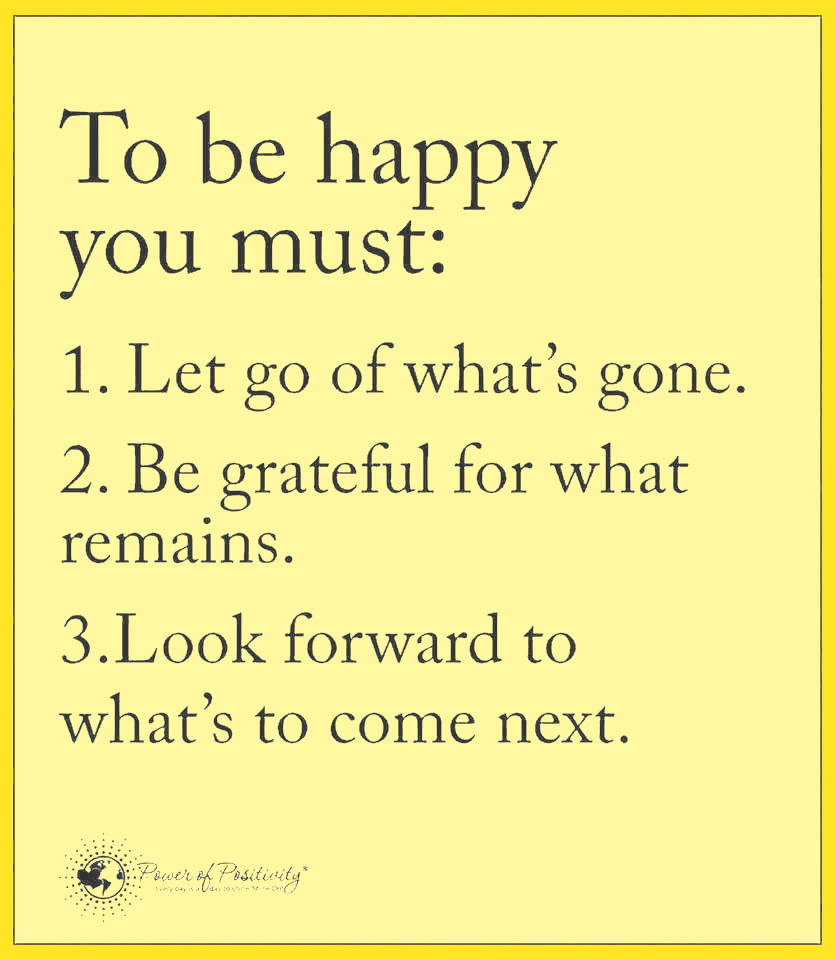
A friend of mine put a poster on Facebook that listed a three-step recipe for happiness from powerofpositivity.com.
“To be happy,” if says, “you must: 1. Let go of what’s gone. 2: Be grateful for what remains. 3. Look forward to what’s to come next.”
Instead of just reading it, maybe thinking “that’s nice,” and then scrolling on to the next post, I paused to give it some thought.
The first step counsels us to “let go of what’s gone.” Whatever has happened–whether it happened two seconds or two decades ago–is done. That moment is gone. Over. Past. And no matter how many times you replay it in your mind, you can’t change it. It’s sort of like the old adage that advises us not to cry over spilled milk because crying won’t put the milk back in the bottle. On the surface, it’s common sense.
But the truth of the matter is that “letting go” is often easier said than done, no matter how wise the advise. Maybe your home—and all it held, including prized possessions and links to precious family events and memories—just blew away in a tornado or burned to the ground in a fire. Maybe a trusted friend betrayed you or a loved one died. Maybe someone made a remark that cut you to your core. Letting go of your attachment to painful experiences isn’t as easy as shrugging your shoulders as if it’s nothing to be bothered about. Sometimes you have to grieve or let yourself feel the sting of outrage. Sometimes you have to absorb life’s shocks and sorrows and give them time to settle and heal.
Nevertheless, “Let go of what’s gone” is worthwhile advice. The key is to be gentle with yourself while you go through the process of releasing, bit by bit, whatever stands in the way of your peace. It can be a struggle, and it can take some time.
For life’s petty annoyances and recurring irritations, though, you can train yourself to let go of them almost as soon as they slide into the past. I say “almost” because to get really speedy at it takes some practice. Here’s why.
When you get upset by anything, the chemistry of your body changes. Being upset is a type of pain, and your brain has to figure out the cause of it so it can send the right kind of healers to your injury. So it looks through its library of causes to find other times when you felt this kind of pain. “Ah-ha!” it says as it calls up the time that kid in third grade tattled on you, or all the times Uncle Harry said mean things to you, or your teacher scolded you, or none of the other kids would let you direct the game. It taps into all those things and might even play a movie of your memories so you can see that your current annoyance is just like the time that . . .
Meanwhile, as your brain looks for similar types of scrapes and bruises, you’re stewing in your irritation juices and it can take a while before the feel-better chemicals that your brain sends calm you back down. BUT if you catch yourself just when you begin to feel upset, you can decide to switch your thoughts to something else instead of the incident that disturbed you. You decide to let go of what’s happening inside your mind, to let go of the story or mental movie that’s grabbed your attention and to purposely turn your attention elsewhere.
You might simply ask yourself, “What’s good about this moment?” (Always a powerful question, by the way.) Or you might set your mind on a physical task that requires a degree of attention. You could ask yourself to recall the details of the first bedroom you remember, or your first bike or family vacation. What was your second grade teacher’s name? What do you remember about her? Little mental games like that will stop the flow of feel-yucky chemicals and your brain won’t have to work as hard to send you the soothing ones.
“Let go of what is gone,” truly is an excellent first step toward happiness. But it’s a process, not an instant fix. Nobody crawls out of the crib and runs a marathon the moment he stands upright. Sometimes letting go is a marathon. But keep practicing those first steps, getting up each time you fall, and in time letting go will be one of your treasured skills, and you will learn to run with it and be free.
Then you begin to play with step two, valuing what’s left. Let’s look at that one together next week.
Meanwhile, enjoy the good stuff! And remember to play.
Warmly,
Susan